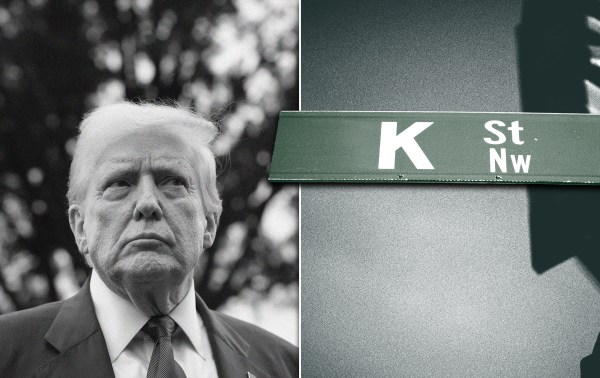In her first speech as John McCain’s running mate in 2008, then-Alaska Gov. Sarah Palin found an applause line by trashing an infamous pork barrel project for her home state, a bridge to replace the ferry that served the airport in Ketchikan, a tourist and cruise ship hub at the southern end of Alaska’s channel islands.
“I told Congress ‘thanks but no thanks’ on that bridge to nowhere,” she said, praising McCain’s efforts to block the funding of the bridge, end “earmark” appropriations, and fighting wasteful pork-barrel spending.
Even if Palin had not been entirely honest in her description of events around the bridge project, her story fit the narrative of her early career in which she presented herself as the scourge of corruption, big spending, and cronyism that she said was rampant in Alaska’s power structure—among people like the $250 million bridge’s greatest champion, Rep. Don Young.
Young’s passion for pork was so intense that he once held a knife to then-Rep. John Boehner’s throat in the House chamber because of Boehner’s hectoring over Young’s insatiable hunger for more earmarks. The “bridge to nowhere” was Young’s baby, and he did not forget the way that Palin and others killed it—or at least danced on its grave.
So while it was not surprising that Palin, who has found herself a followless leader after a decade of flake-outs and flummery, announced Friday that she was entering the special election to serve out the remainder of Young’s term as Alaska’s lone representative, her stated purpose for running was noteworthy.
“Public service is a calling, and I would be honored to represent the men and women of Alaska in Congress, just as Rep. Young did for 49 years,” Palin said in a statement. “I realize that I have very big shoes to fill, and I plan to honor Rep. Young’s legacy by offering myself up in the name of service to the state he loved and fought for.”
Palin promising to replicate the service of Young tells us about a few things: The demise of the “reform” conservatism that seemed vigorous even as recently as 2015; the gall of a woman who couldn’t even finish one term as governor; and the strangeness of Alaska politics.
Alaska politics are wild and wooly, but insular, too. Just consider the first family of Alaska politics, the Murkowskis. Longtime Sen. Frank Murkowski was just the third person to hold his seat when he was elected in 1980. When he resigned from the Senate after becoming governor in 2002, he appointed his own daughter, Lisa, to replace him in Washington. The nepotism charge against Frank Murkowski helped Palin defeat him in the 2006 gubernatorial primary. Of course, when the Palin-backed candidate defeated Lisa Murkowski in the 2010 Republican Senate primary, she proved she was a political power in her own right, winning a stunning write-in bid in the general election. If you can get about 100,000 people to spell “Murkowski” right, that’s a serious flex.
The field to replace Young includes state Sen. Josh Revak, a combat-injured Iraq veteran who worked in Young’s office for six years before running for the state House and eventually getting appointed to the state Senate. He seems to have to have the backing of Young’s crew and a good rapport with Republican Gov. Mike Dunleavy. The Murkowski faction is represented in the field by Tara Sweeney, a Cabinet secretary under Frank Murkowski who served as assistant secretary of the interior for Indian affairs during the Trump administration. Nick Begich III, the grandson of the congressman whom Young was elected to replace in a special election 49 years ago, is running, too. Begich got in the race for the full term starting in 2023 before Young’s death but is now also in the hunt for the unexpired term.
The real full-circle candidate, though, is Emil Notti, the Democrat whom Young narrowly defeated to win his first term in 1973. The 89-year-old Native leader told the Anchorage Daily News “I’m not looking at a long-term career, so it wasn’t really a hard decision.”
The other 43 candidates include the garden columnist for the Anchorage Daily News, who is also a leading authority on organic cannabis cultivation, and a member of the city of North Pole’s council whose legal name is Santa Claus. (You will not be surprised to learn that he is a self-described “independent, progressive, Democratic socialist.”)
Even the election procedures are weird. Voters have until June 11 to mail in or drop off their ballots, which will be tallied on June 26. The top four finishers, regardless of party, will advance to the August 16 election, when a winner will be chosen by ranked-choice voting. Voters will be allowed to rank the candidates 1 through 4, with their vote rolling over to their next-highest choice until one candidate gets more than 50 percent of the total. The winner will then serve out the remaining five-and-a-half months of Young’s term.
Here’s where it gets Last Frontier-weird: June 26 is also the day for the regular primary for the full term starting in January, which will also use ranked-choice to pick the final four candidates for the November general election. Voters will see two different sets of candidates for the same seat, meaning they could choose up to eight different individuals to serve in the state’s sole House seat.
So even without the state’s re-re-re-invented former governor’s arrival, the race to replace Young would have been a doozy. Now it will just be a doozy with national media attention.







Please note that we at The Dispatch hold ourselves, our work, and our commenters to a higher standard than other places on the internet. We welcome comments that foster genuine debate or discussion—including comments critical of us or our work—but responses that include ad hominem attacks on fellow Dispatch members or are intended to stoke fear and anger may be moderated.
With your membership, you only have the ability to comment on The Morning Dispatch articles. Consider upgrading to join the conversation everywhere.